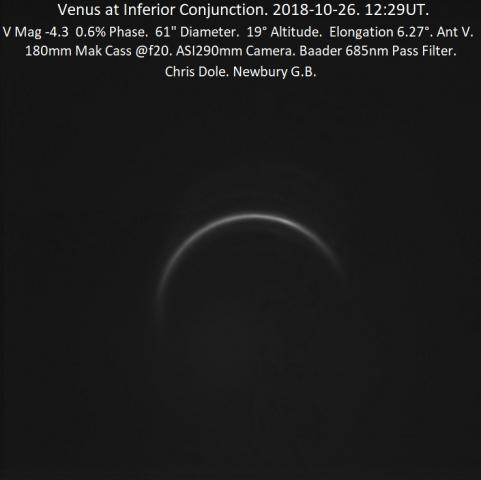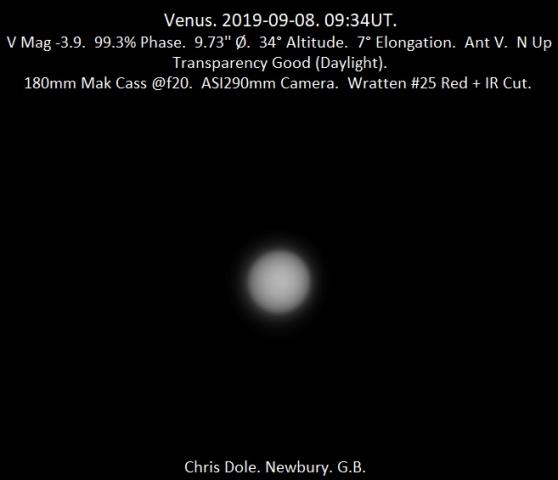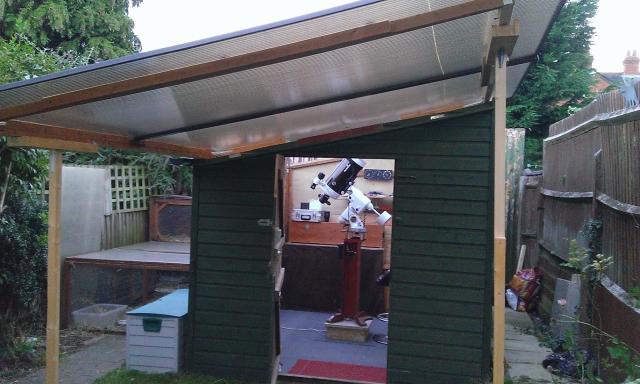Forum Replies Created
-
AuthorPosts
-
 Chris DoleParticipant
Chris DoleParticipantHello Grant.
I tend to suffer exactly the same problem with my Dall Kirkham. Rarely any moisture when observing but if I check the scope during the day there is often condensation on the primary at this time of year.
My scope has three small cooling fans behind the primary. They pull air down the tube from the open/secondary end past the primary. They are very effective at clearing the moisture even though that isn’t their primary purpose. To combat any dust concerns I put a doubled up old piece of net curtain over the open end to act as a filter but to ensure good airflow.
I’ve recently started using packets of silica gel inside the tube when the scope isn’t in use. This seems to help, as long as they are regularly recharged in a warm oven and the tube is fairly well sealed.
It’s a really annoying problem that I’m still working my way through.Chris.
 Chris DoleParticipant
Chris DoleParticipantSorry all. My poor choice of words may have led to a misunderstanding. I just think that restrictions may have little effect in this instance.
Apologies.
 Chris DoleParticipant
Chris DoleParticipantMaybe. But isn’t that just another form of social distancing, which is no longer required?
Same goes for masks. Of course people should be allowed to wear them if they want but it shouldn’t be a requirement.
Perfectly understandable if people would rather not attend but people who want to go shouldn’t be impacted.
It must be remembered that attendance is purely voluntary and supposed to be fun (I just about remember that). Even the staff will be attending crowded pubs, bars, clubs, sports stadiums, concerts, theatres and public transport etc. I think imposing restrictions is indefensible.
 Chris DoleParticipant
Chris DoleParticipantPeter, I’m totally in agreement with you on this. I fully understand where the south up convention comes from but for decades now I would say that most observers have been using equipment that shows a north up image.
When I submit observations I have to deliberately turn everything upsidedown which seems odd and is just irritating. Surely it’s time to move to a global north up standard?
Chris
 Chris DoleParticipant
Chris DoleParticipantHello.
I wouldn’t recommend using grub screws on a carbon tube of 1.5mm. I imagine that the screws would need to be quite tight and this could damage the tubing. A thicker wall thickness, say 3mm, would be more resilient although some marring may still occur.
Chris.
 Chris DoleParticipant
Chris DoleParticipantThanks Jeremy. That seems to have fixed the issue.
Chris.
 Chris DoleParticipant
Chris DoleParticipantHi James,
The closest I’ve managed is a tad over 6°. Great care must be taken of course. Seeing conditions are always horrific but I like a challenge!


 Chris DoleParticipant
Chris DoleParticipantJust went outside (11pm ish) and was lucky enough to catch a fair sized gap in the clouds here in Berkshire. Megrez appeared as I would expect, easily seen. It was certainly much harder to see last night. Perhaps haze?
Chris.
 Chris DoleParticipant
Chris DoleParticipantHello all.
Just to add that a look upwards last night from my fairly light polluted location revealed Megrez to be ‘missing’. If I looked a little longer I could just about make it out. This has never been the case in the past and the familiar pattern has always been obvious.
Chris.
 Chris DoleParticipant
Chris DoleParticipantWithout cheating and looking it up, I’ve always thought that Venus is the closest most frequently, Mars occasionally and Mercury very infrequently. So overall I’d say Venus. I have a feeling that I may be mistaken though!
Although it’s not really clear from the question whether it’s about time overall or specific occasions.
 Chris DoleParticipant
Chris DoleParticipantFinally had a response from the famously flaky and halfhearted West Berkshire council.
“the majority of LED street lights installed in West Berkshire have a colour temperature of 5000K. Dimming takes place between Midnight and 05:30 and the level of dimming depends on the location and road type, but in general the reduction is around 25%.”
I have to say that I’ve seen no evidence of dimming but at only 25% I doubt I’d notice.
 Chris DoleParticipant
Chris DoleParticipantI totally agree with Gary. I cast my vote electronically and also found it quick and easy. Excellent stuff.
Chris.
 Chris DoleParticipant
Chris DoleParticipantI’ll be ordering a copy soon!
The image on the front cover threw me for a few moments. Then I realised that its a view looking down from above the Northern Hemisphere.
Chris.
 Chris DoleParticipant
Chris DoleParticipantThe polycarbonate is screwed to the frame using standard fittings from B&Q which include a rubber doughnut to seal it from water. Very cheap. The roof is 9′ x11′ and in total weighs about 20kg. Probably to much to hinge but easy to slide by hand without the complication of wheels & tracks etc.
I’m also keen not to lose to much garden, and my upright roof supports are removable. I have steel square section tubes set into the grass and the supports slot in when required and stored in the shed when not…easy.
Size wise I would say that 7′ square would be very tight. For the set up you describe I’d say 8×10 for comfort and 8×8 as absolute minimum.
Never had an issue with creepy crawlies. Maybe the daylight puts them off.
 Chris DoleParticipant
Chris DoleParticipantHello Grant.
When I moved into my house some years back, there was an existing shed in the garden. I converted it into a runoff roof observatory. I made a roof from 16mm poly carbonate sheets on a simple wooden frame. It slides on PTFE runners. In the six years it has been in use, I have never had any condensation whatsoever on any surface. It’s well ventilated around the roofline which makes the difference I believe. A big advantage is that during the day it’s full of natural light. The whole project probably cost a few hundred quid including replacing some rotten shiplap.
Hope this helps.

Chris.
 Chris DoleParticipant
Chris DoleParticipantNick, Managed to get this image just after conjunction. Took me ages as I was struggling with cirrus, terrible seeing and gusts of wind. It’s not great but I’m amazed it’s as good as it is considering the conditions.
.jpg)
Chris.
 Chris DoleParticipant
Chris DoleParticipantAlthough I’m far from an expert in these matters, I believe your correct about the converging beam introducing astigmatism. To achieve the correct image scale, these ADCs are usually used behind a Barlow. Would this limit the astigmatism? And does the long resulting focal ratios achieved (>f20) limit the effect? I know that in practice I see improvement in image quality.
The attached image was taken at 17° altitude with a 7″ telescope in July. I can’t replicate this without the ADC without nasty colour fringing.
.jpg)
Chris.
 Chris DoleParticipant
Chris DoleParticipantI’ve been using a ZWO ADC for several months now. Simple to use, especially with a Mak, SCT or refractor. With the planets being lower down from Great Britain in the coming years, getting one could be a worthwhile investment. The ZWO version is about £130 I believe, not cheap but they were a lot more expensive in the past.
The bigger the aperture the more benefit you’ll see, and I see a noticeable improvement even in my 7″ Maksutov when imaging below about 30° altitude.
Chris.
 Chris DoleParticipant
Chris DoleParticipantWas keen to have a go at this, so went to my observatory at about 5am to set up. Firstly my mount wouldn’t connect to my laptop. Eventually fixed this. Then the batteries in my controller went. Fixed this. Then my laptop froze. After a short period of mild pandemonium I fixed this also. Anyway, after the dust had settled I checked my timings relative to others and think I missed the end of the event by a matter of seconds! Next time I will double check everything and give myself more time. Enjoyed it anyway!
Chris
-
AuthorPosts
